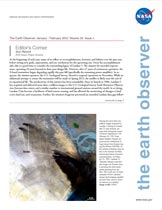The Earth Observer has a new look! Visit the NEW Earth Observer website.
The Earth Observer: Jan - Feb, 2012
In This Issue
Click title below to view page
- Editor’s Corner Front Cover
- Feature Articles
- NASA’s Hyperwall Has Become Quite the Globetrotter 4
- NASA’s Applied Sciences Program—Earth Science Serving Society 8
- The NASA-GPM and DOE-ARM Midlatitude Continental Convective Clouds Experiment (MC3E) 12
- Blog Log 19
- Meeting/Workshop Summaries
- Summary of the International Year of Chemistry Symposium on Stratospheric Ozone and Climate Change 21
- 2011 GRACE Science Team Meeting Summary 22
- Land-Cover/Land-Use Change Science Team Session at the 2011 NASA Carbon Cycle and Ecosystems Joint Science Workshop: Observations and Data for Land-Use Change with a Focus on Agriculture 27
- Passive Microwave Data Set Management Workshop 30
- In The News
- NASA Finds Japan Tsunami Waves Merged, Doubling Power 32
- NASA’s GRACE Helps Monitor U.S. Drought 33Satellite Data Shows that Kirtland’s Warblers Prefer Forests After Fire 34
- Regular Features
- NASA Earth Science in the News 36
- NASA Science Mission Directorate – Science Education and Public Outreach Update 38
- Science Calendars 39
Editor's Corner
Steve Platnick, EOS Senior Project Scientist
At the beginning of each year, many of us reflect on accomplishments, fortunes, and failures over the past year before setting new goals, expectations, and yes, resolutions for the upcoming one. From the accomplishment side, this is a good time to consider the outstanding legacy of Landsat 5. The mission far exceeded expectations, operating 24 years beyond its three-year design life. However, after 27 years of continuous operation, the X-band transmitter began degrading rapidly this past fall (specifically the remaining power amplifier). In response, the mission operator, the U.S. Geological Survey, elected to suspend operations in November. While an additional attempt to restart the transmitter will be made in Spring 2012, the satellite is likely near the end of its operational life. The productivity of this mission has been remarkable. Since its launch in 1984, Landsat-5 has acquired and delivered more than a million images to the U.S. Geological Survey Earth Resources Observation Systems data center, and a similar number to international ground stations around the world. In so doing, Landsat-5 has become a backbone of land remote sensing, and has allowed the monitoring of changes to land cover, land use, and ecosystems. Further, the mission’s longevity prevented an extended Landsat data gap following...
Read more...

